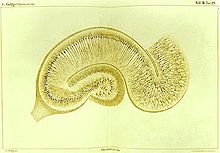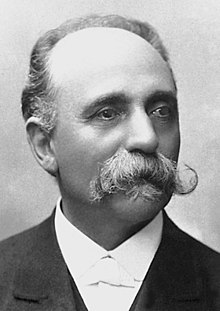Camillo Golgi

Camillo Golgi (born July 7, 1843 in Corteno Golgi , Brescia , Italy ; † January 21, 1926 in Pavia , Italy) was an Italian physician and histologist . In 1906 he received the Nobel Prize for Physiology or Medicine together with Santiago Ramón y Cajal for his investigations into the fine tissue anatomy of the nervous system .
Golgi developed the Golgi stain named after him , a method for staining individual nerves and cell structures , which became known as the " black reaction ". It was a histological staining with silver nitrate , about which Golgi published in 1873. For most of his life, Golgi tried to improve and refine this method, which was made internationally known by Albert von Koelliker . Through them he discovered u. a. the Golgi apparatus named after him and the Golgi cells in the brain (in the cerebellar cortex ) that he described in 1875 .
Life
Golgi was born the son of a doctor. He studied medicine and received his doctorate in 1865 from the University of Pavia . His academic teachers were especially Paolo Mantegazza , Giulio Bizzozero and Eusebio Oehl . After graduating, he continued his work at the St. Matteo Hospital . In 1872 he took over the position of chief doctor at the hospital for chronic diseases in Abbiategrasso . Here he began his groundbreaking work on the nervous system in a converted kitchen. In 1876 Golgi returned to the University of Pavia as Associate Professor of Histology , and in 1881, after a brief stay in Siena, he was appointed to the Chair of General Pathology . In 1890 he identified the three different pathogens causing malaria and developed a method to photograph the stages of the parasite . During the First World War, Golgi campaigned for a military hospital in Pavia. Here he set up a neuropathological and mechanopathological institute for studying and treating injuries to the peripheral nervous system .
In 1881 Camillo Golgi married the niece of his teacher Bizzozero, Donna Lina. They did not have children of their own, but did adopt his niece Carolina.
Honors and memberships
- 1890: Member of the Leopoldina
- 1892: Corresponding member (from 1906 external member) of the Göttingen Academy of Sciences
- 1905: Corresponding member of the Russian Academy of Sciences
- 1906: Nobel Prize in Physiology or Medicine in recognition of your work on the structure of the nervous system
- 1911: Corresponding member of the Prussian Academy of Sciences
- 1914: Admission to the Order Pour le mérite for Science and the Arts (January 24, 1914)
- 1916: Honorary Fellow of the Royal Society of Edinburgh
- 1976: Name of the lunar crater Golgi after him.
- 2017: Naming of the asteroid (6875) Golgi after him.
literature
- Werner E. Gerabek : Golgi, Camillo. In: Werner E. Gerabek, Bernhard D. Haage, Gundolf Keil , Wolfgang Wegner (eds.): Enzyklopädie Medizingeschichte. De Gruyter, Berlin / New York 2005, ISBN 3-11-015714-4 , p. 501 f.
- Reinhard Hildebrand: Rudolf Albert Koelliker and his scientific contacts abroad. In: Würzburg medical history reports. Volume 2, 1984, pp. 101-115; here: p. 111.
Individual evidence
- ↑ Werner E. Gerabek : Reinhard Hildebrand: The Würzburg anatomist Albert von Koelliker in his relationship with Camillo Golgi and Santiago Ramón y Cajal. In: Sudhoff's archive. Volume 73, 1989, pp. 145-155; in: Würzburg medical history reports. Volume 13, 1995, p. 557.
- ^ Camillo Golgi | ORDER POUR LE MÉRITE. Retrieved October 23, 2018 .
- ↑ Holger Krahnke: The members of the Academy of Sciences in Göttingen 1751-2001 (= Treatises of the Academy of Sciences in Göttingen, Philological-Historical Class. Volume 3, Vol. 246 = Treatises of the Academy of Sciences in Göttingen, Mathematical-Physical Class. Episode 3, vol. 50). Vandenhoeck & Ruprecht, Göttingen 2001, ISBN 3-525-82516-1 , p. 95.
- ↑ OPLM: Camillo Golgi ; Vita .
- ^ Fellows Directory. Biographical Index: Former RSE Fellows 1783–2002. Royal Society of Edinburgh, accessed December 9, 2019 .
Web links
- Information from the Nobel Foundation on the 1906 award ceremony for Camillo Golgi (English)
| personal data | |
|---|---|
| SURNAME | Golgi, Camillo |
| BRIEF DESCRIPTION | Italian medic and physiologist |
| DATE OF BIRTH | July 7, 1843 |
| PLACE OF BIRTH | Corteno , Italy |
| DATE OF DEATH | January 21, 1926 |
| Place of death | Pavia |
